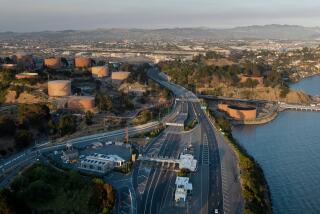Ambitious Goals for Long Road Ahead Drive Small Giant
- Share via
Chevron Corp. has something to prove. With oil and gas in great demand and prices going up, global energy companies are hot investments again.
Exxon Mobil Corp. and BP Amoco, two “super-majors” created by oil’s recent merger wave, sell at premium prices for their industry; Royal Dutch/Shell Group, another giant, also has the stock market’s support.
But investors moderate their enthusiasm for Chevron, which bid to merge with Texaco Inc. last year but was rejected. Chevron’s stock is up 11% so far this year, but it sells at less of a premium than oil’s mega-firms.
So Chevron, though big itself at 30,000 employees and more than $38 billion in annual revenue, must fight like a David among Goliaths--to impress investors and to gain its share of a strongly growing global energy business.
David O’Reilly, Chevron’s new chief executive, says the firm must pick its spots.
“It’s important for us to be big in scale wherever we go and to focus investments wisely because of the capital intensity of our business,” O’Reilly said in an interview last week.
O’Reilly, who assumed the top job in January, has set the industry’s most ambitious goals: “We must be No. 1 in return to shareholders in the years 2000 to 2004,” he says.
“We must grow earnings per share faster than our competitors--15% a year for the next three years.”
Also, he wants to achieve a higher return on capital--a key measure for today’s energy business--and he pledges that Chevron will increase its production of oil and gas 4% to 4.5% a year for the next four years. That’s a faster pace than other companies contemplate and an indication of how Chevron views the outlook for oil.
It sees growing use of energy in a world developing everywhere and turning to the new economy of information, computers and the Internet.
“We’re gobbling up energy more and more each year--4% of energy demand was attributable to computers a decade ago; now it’s 14% and growing,” O’Reilly says.
But O’Reilly doesn’t see oil and gas prices remaining high.
“Oil at $30 a barrel is unsustainable,” he says--a call that will look good this week if, as expected, the Organization of Petroleum Exporting Countries boosts production to ease global price pressures.
Chevron’s long-term plans for investment and profit are based on an average of $19 a barrel, a level 40% below last week’s peak.
Oil and gas prices are controversial again. Gasoline at more than $2 a gallon in Chicago--the result of short supplies of a new federally mandated lower-polluting blend--is sparking arguments and finger-pointing between government and business. Last week a congressman accused oil companies of gouging.
Yet on Wall Street the industry is seen as anything but a big profit producer. Oil company returns on investment are low compared with those of most other industries and a pittance compared with the profit margins of Microsoft, Dell Computer and the high-tech world.
In fact, the oil business is criticized for investing so much to develop and produce new oil and gas deposits.
“It’s a critical problem,” says Joseph Stanislaw of Cambridge Energy Research Associates. The companies need to invest to develop energy supplies to meet rising world demand. “Yet the returns on investment are long term”--over decades--and the stock market today doesn’t like to wait.
Which is a pity, because real value is created in the long term. Chevron is a mirror for the industry’s history and its future. If we look at the company’s prospects and challenges, we can understand what lies ahead.
Chevron--founded in San Francisco in 1879, later part of the Standard Oil Trust and the first company to discover oil in Saudi Arabia--is looking at years of growing oil and gas production from Nigeria and Angola, from the U.S. Gulf of Mexico and Canada’s Northwest Territories, and from Indonesia and South America.
Thanks to developments in those areas during the last 30 years, Chevron can confidently forecast annual cash flows of tens of billions of dollars.
But its largest project at present is the Tengiz field in Kazakhstan in Central Asia. Tengiz, a 40-year project being developed at a cost of $20 billion, is an oil and gas deposit comparable in size to the North Sea or Alaska’s North Slope, both of which have produced for almost 30 years and are still going strong.
Chevron is producing profitably at Tengiz today and shipping oil out in rail cars. But soon a pipeline will be completed to carry the oil through Russia to the Black Sea, and that will enhance the returns. It is the kind of project that alters a region and a world, not to mention a company.
But Chevron is an old hand at altered states. The company, then called Standard Oil of California, discovered the first oil in Saudi Arabia. It was invited by King Abdulaziz al Saud, founder of the modern country, to drill in 1933 and produced oil at Dammam in 1938. After World War II, the abundance of Saudi and other Mideast oil transformed world economies.
But there is a crucial difference between Chevron’s discovery in Saudi Arabia and its development of Kazakhstan. In earlier times, oil companies owned what they discovered in foreign lands. When those countries took back ownership of their resources in the 1970s, many experts thought the companies were headed for oblivion. But in fact it was the making of a modern industry, reliant on knowledge and skills rather than ownership of resources.
Chevron and other companies have won the right to develop oil and share in the profits all over the world because of their skills and grasp of advanced technology.
The shift has resulted in many more countries producing oil and gas and in an industry that is more reliant on knowledge and, yes, more profitable.
But the investing world is also more impatient today. If Chevron has to wait for good profit to flow from Kazakhstan, then it must cut costs elsewhere. The market is looking for discipline of capital, says analyst Steve Enger of Petrie Parkman & Co., a Denver research and investment firm.
Chevron has trimmed and shaped U.S. operations.
“We used to have 4,000 producing oil wells in the U.S.; now we have 300,” O’Reilly says. “But the ones we have are larger and produce more.”
And in the future, technology will be the source of most of the cost reductions, says O’Reilly, a chemical engineer from University College Dublin, in Ireland, where he was born 53 years ago.
Chevron’s idea of technology goes beyond that of most oil companies. It has invested $60 million to set up a venture capital fund, Chevron Technologies, to invest in start-ups. “The fund opens us to contact with completely different technologies,” says Donald Paul, vice president of technology.
“For example, we have an investment in a company named Alumina that deposits thousands of sensors on the end of fiber-optic cables to detect organic molecules,” Paul says. “Well, we detect organic molecules all the time in our process plants and oil wells.”
So Chevron can contribute product development to the small company and its own operations and profit from the success of both. Chevron is also joining oil industry efforts to cut costs by ordering supplies on the Internet.
Still, the company will need both luck and technology to overcome the burden of its size. Like its larger rivals, Chevron must maintain a heavy flow of investment in exploration and development. But the rivals have more capital to draw upon--Exxon Mobil, BP Amoco and Royal/Dutch Shell are all four times Chevron’s size in total stock market value. So Chevron is an economy-sized giant with a jumbo-sized challenge.
Will it make it on its own? For the moment, it will have to. A merger with Texaco may never have made much sense and now is last year’s news.
“I don’t see what advantage they would get from merging with Texaco,” says analyst Louis Gagliardi of John S. Herold Inc., an oil and gas research firm in Stamford, Conn.
Chevron could strengthen itself by acquiring a good, smaller firm such as Phillips Petroleum Co., USX/Marathon Group or Conoco Inc. But before Chevron could do that, it would have to get its own stock price up to a premium--which means fulfilling its ambitious goals.
So the company’s future comes down to the next few years’ performance.
“They have exceptional prospects overseas,” notes Douglas Terreson, the Houston-based analyst of Morgan Stanley. “But clearly the investment market is watching them right now.”
It’s the company with something to prove.
*
James Flanigan can be reached at jim.flanigan@latimes.com.
(BEGIN TEXT OF INFOBOX / INFOGRAPHIC)
David Versus Goliaths
Although Chevron is smaller in terms of market capitalization* than its new merged rivals, it maintains a proportionately higher level of expenditures for oil exploration and capital investment.
Chevron trails in market capitalization...
Chevron: $60,5 billion
...and planned 2000 capital investment...
Chevron: $5.2 billion
...but invests more as proportion of its market capitalization.
Chevron: 8.6%
*Stock price times shares outstanding
**1999 expenditure
Source: Bloomberg News, Value Line, Salomon Smith Barney, company reports
More to Read
Inside the business of entertainment
The Wide Shot brings you news, analysis and insights on everything from streaming wars to production — and what it all means for the future.
You may occasionally receive promotional content from the Los Angeles Times.










